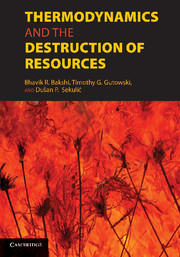Book contents
- Frontmatter
- Contents
- Contributor List
- Foreword by Herman E. Daly
- Foreword by Jan Szargut
- Preface
- Introduction
- PART I FOUNDATIONS
- PART II PRODUCTS AND PROCESSES
- PART III LIFE-CYCLE ASSESSMENTS AND METRICS
- PART IV ECONOMIC SYSTEMS, SOCIAL SYSTEMS, INDUSTRIAL SYSTEMS, AND ECOSYSTEMS
- Appendix: Standard Chemical Exergy
- Index
Foreword by Jan Szargut
Published online by Cambridge University Press: 01 June 2011
- Frontmatter
- Contents
- Contributor List
- Foreword by Herman E. Daly
- Foreword by Jan Szargut
- Preface
- Introduction
- PART I FOUNDATIONS
- PART II PRODUCTS AND PROCESSES
- PART III LIFE-CYCLE ASSESSMENTS AND METRICS
- PART IV ECONOMIC SYSTEMS, SOCIAL SYSTEMS, INDUSTRIAL SYSTEMS, AND ECOSYSTEMS
- Appendix: Standard Chemical Exergy
- Index
Summary
Human production activity is based on natural resources. Their usefulness results from the ability to be transformed into useful products necessary for humans. That ability may be evaluated by means of the laws of thermodynamics that express not only the conservation of energy but also its tendency to be dissipated. The dissipation of energy (resulting in entropy generation) decreases its usefulness and reduces its ability to be transformed into useful products. The mentioned ability may be evaluated by means of the maximum work attainable in a reversible transition to the equilibrium with the environment embracing that part of nature that belongs to the area of human production activity. That quantity is usually called “exergy.”
A considerable part of the natural resources utilized by humans belongs to the nonrenewable ones (organic and nuclear fuels, ores of metals, inorganic minerals). The usefulness of nonrenewable resources results from their chemical composition. The chemical exergy can be accepted as a general quality measure of the mentioned resources because it expresses the maximum work attainable during the transition to equilibrium with a dead environment.
However, equilibrium with the natural environment is not possible, because it does not appear in the real natural environment. As proved by Ahrendts [1], the concentration of free oxygen in an equilibrium environment would be very small because the prevailing part of oxygen would be bound with nitrogen in nitrates. Fortunately the formation of nitrates is kinetically blocked, and they appear very seldom in nature.
- Type
- Chapter
- Information
- Thermodynamics and the Destruction of Resources , pp. xvii - xxPublisher: Cambridge University PressPrint publication year: 2011



